Structural and Physiological Modeling (SAPM) for the Analysis of Functional MRI Data Applied to a Study of Human Nociceptive Processing
Abstract
1. Introduction
2. Materials and Methods
2.1. Participants
2.2. Participant Training and fMRI Study Methods
2.3. Functional MRI Data Acquisition
2.4. Analysis Methods
2.4.1. Pre-Processing
2.4.2. Anatomical Regions
2.5. Validating the Network Model
2.5.1. Network Analysis
2.5.2. Identifying Connections
2.6. Structural and Physiological Modeling (SAPM)
2.6.1. The Basic Concept
2.6.2. Setting Up the Model
2.6.3. Solving the Model to Estimate Input and Output Signaling
2.6.4. The Gradient-Descent Method to Determine the Values in Minput and Moutput
2.6.5. Dealing with Different Variance across Regions
2.6.6. Validating the Method and Testing Statistical Thresholds with “Null” Data
2.6.7. Sub-Region Search
2.7. Applying the Methods to Data from Pain Studies
3. Results
3.1. Results of Tests with “Null” Data
3.2. Results of Applying the Methods to Data from Pain Studies
4. Discussion
4.1. Validation with “Null” Tests
4.2. Validation with fMRI Data
4.3. Comparisons of SAPM Results with Known Neuroanatomy
4.4. Limitations and Future Directions
5. Conclusions
Author Contributions
Funding
Institutional Review Board Statement
Informed Consent Statement
Data Availability Statement
Acknowledgments
Conflicts of Interest
References
- Stroman, P.W.; Powers, J.M.; Ioachim, G. Proof-of-concept of a novel structural equation modelling approach for the analysis of functional magnetic resonance imaging data applied to investigate individual differences in human pain responses. Hum. Brain Mapp. 2023, 44, 2523–2542. [Google Scholar] [CrossRef] [PubMed]
- Stroman, P.W.; Powers, J.M.; Ioachim, G.; Warren, H.J.M.; McNeil, K. Investigation of the neural basis of expectation-based analgesia in the human brainstem and spinal cord by means of functional magnetic resonance imaging. Neurobiol. Pain. 2021, 10, 100068. [Google Scholar] [CrossRef] [PubMed]
- Stroman, P.W.; Bosma, R.L.; Cotoi, A.I.; Leung, R.H.; Kornelsen, J.; Lawrence-Dewar, J.M.; Pukall, C.F.; Staud, R. Continuous Descending Modulation of the Spinal Cord Revealed by Functional MRI. PLoS ONE 2016, 11, e0167317. [Google Scholar] [CrossRef] [PubMed]
- Vierck, C.J., Jr.; Cannon, R.L.; Fry, G.; Maixner, W.; Whitsel, B.L. Characteristics of temporal summation of second pain sensations elicited by brief contact of glabrous skin by a preheated thermode. J. Neurophysiol. 1997, 78, 992–1002. [Google Scholar] [CrossRef] [PubMed]
- Bosma, R.L.; Ameli Mojarad, E.; Leung, L.; Pukall, C.; Staud, R.; Stroman, P.W. Neural correlates of temporal summation of second pain in the human brainstem and spinal cord. Hum. Brain Mapp. 2015, 36, 5038–5050. [Google Scholar] [CrossRef]
- Muller, M.; Bleeck, J.; Ruf, M. Vertebral artery anomaly with entry at C4—Avoiding a surgical pitfall: A case report. Eur. Spine J. 2008, 17 (Suppl. S2), S291–S293. [Google Scholar] [CrossRef][Green Version]
- De Leener, B.; Fonov, V.S.; Collins, D.L.; Callot, V.; Stikov, N.; Cohen-Adad, J. PAM50: Unbiased multimodal template of the brainstem and spinal cord aligned with the ICBM152 space. Neuroimage 2018, 165, 170–179. [Google Scholar] [CrossRef]
- Naidich, T.P.; Duvernoy, H.M.; Delman, B.N.; Sorensen, A.G.; Kollias, S.S.; Haacke, E.M. Internal Architecture Of The Brain Stem With Key Axial Sections. In Duvernoy’s Atlas of the Human Brain Stem and Cerebellum; Springer-Verlag/Wien: New York, NY, USA, 2009; pp. 79–82. [Google Scholar]
- Whitfield-Gabrieli, S.; Nieto-Castanon, A. Conn: A functional connectivity toolbox for correlated and anticorrelated brain networks. Brain Connect. 2012, 2, 125–141. [Google Scholar] [CrossRef]
- Millan, M.J. Descending control of pain. Prog. Neurobiol. 2002, 66, 355–474. [Google Scholar] [CrossRef]
- De Leener, B.; Levy, S.; Dupont, S.M.; Fonov, V.S.; Stikov, N.; Louis Collins, D.; Callot, V.; Cohen-Adad, J. SCT: Spinal Cord Toolbox, an open-source software for processing spinal cord MRI data. Neuroimage 2017, 145, 24–43. [Google Scholar] [CrossRef]
- Lang, J.; Bartram, C.T. Fila radicularia of the ventral and dorsal radices of the human spinal cord. Gegenbaurs Morphol. Jahrb. 1982, 128, 417–462. [Google Scholar] [PubMed]
- Liebe, T.; Kaufmann, J.; Li, M.; Skalej, M.; Wagner, G.; Walter, M. In vivo anatomical mapping of human locus coeruleus functional connectivity at 3 T MRI. Hum. Brain Mapp. 2020, 41, 2136–2151. [Google Scholar] [CrossRef] [PubMed]
- Chiang, M.C.; Bowen, A.; Schier, L.A.; Tupone, D.; Uddin, O.; Heinricher, M.M. Parabrachial Complex: A Hub for Pain and Aversion. J. Neurosci. 2019, 39, 8225–8230. [Google Scholar] [CrossRef] [PubMed]
- Talairach, J.; Tournoux, P. Co-Planar Stereotaxic Atlas of the Human Brain; Thieme Medical Publishers, Inc.: New York, NY, USA, 1988. [Google Scholar]
- Leijnse, J.N.; D’Herde, K. Revisiting the segmental organization of the human spinal cord. J. Anat. 2016, 229, 384–393. [Google Scholar] [CrossRef] [PubMed]
- Pauli, W.M.; Nili, A.N.; Tyszka, J.M. A high-resolution probabilistic in vivo atlas of human subcortical brain nuclei. Sci. Data 2018, 5, 180063. [Google Scholar] [CrossRef] [PubMed]
- Keren, N.I.; Lozar, C.T.; Harris, K.C.; Morgan, P.S.; Eckert, M.A. In vivo mapping of the human locus coeruleus. Neuroimage 2009, 47, 1261–1267. [Google Scholar] [CrossRef]
- Stroman, P.W.; Warren, H.J.M.; Ioachim, G.; Powers, J.M.; McNeil, K. A comparison of the effectiveness of functional MRI analysis methods for pain research: The new normal. PLoS ONE 2020, 15, e0243723. [Google Scholar] [CrossRef]
- Stroman, P.W. Validation of Structural Equation Modeling Methods for Functional MRI Data Acquired in the Human Brainstem and Spinal Cord. Crit. Rev. Biomed. Eng. 2016, 44, 227–241. [Google Scholar] [CrossRef]
- Bernard, J.F.; Bester, H.; Besson, J.M. Involvement of the spino-parabrachio -amygdaloid and -hypothalamic pathways in the autonomic and affective emotional aspects of pain. Prog. Brain Res. 1996, 107, 243–255. [Google Scholar] [CrossRef]
- Bester, H.; Besson, J.M.; Bernard, J.F. Organization of efferent projections from the parabrachial area to the hypothalamus: A Phaseolus vulgaris-leucoagglutinin study in the rat. J. Comp. Neurol. 1997, 383, 245–281. [Google Scholar] [CrossRef]
- Chiang, M.C.; Nguyen, E.K.; Canto-Bustos, M.; Papale, A.E.; Oswald, A.M.; Ross, S.E. Divergent Neural Pathways Emanating from the Lateral Parabrachial Nucleus Mediate Distinct Components of the Pain Response. Neuron 2020, 106, 927–939.e925. [Google Scholar] [CrossRef] [PubMed]
- Leite-Almeida, H.; Valle-Fernandes, A.; Almeida, A. Brain projections from the medullary dorsal reticular nucleus: An anterograde and retrograde tracing study in the rat. Neuroscience 2006, 140, 577–595. [Google Scholar] [CrossRef] [PubMed]
- Almeida, A.; Cobos, A.; Tavares, I.; Lima, D. Brain afferents to the medullary dorsal reticular nucleus: A retrograde and anterograde tracing study in the rat. Eur. J. Neurosci. 2002, 16, 81–95. [Google Scholar] [CrossRef]
- Lima, D.; Almeida, A. The medullary dorsal reticular nucleus as a pronociceptive centre of the pain control system. Prog. Neurobiol. 2002, 66, 81–108. [Google Scholar] [CrossRef] [PubMed]
- Almeida, A.; Storkson, R.; Lima, D.; Hole, K.; Tjolsen, A. The medullary dorsal reticular nucleus facilitates pain behaviour induced by formalin in the rat. Eur. J. Neurosci. 1999, 11, 110–122. [Google Scholar] [CrossRef] [PubMed]
- Terman, G. Stimulation-Produced Analgesia. In Encyclopedia of Pain; Schmidt, R., Willis, W., Eds.; Springer: Berlin/Heidelberg, Germany, 2007. [Google Scholar]
- Ioachim, G.; Warren, H.J.M.; Powers, J.M.; Staud, R.; Pukall, C.; Stroman, P.W. Altered pain responses in fibromyalgia during the anticipation and experience of acute pain investigated by means of functional magnetic resonance imaging in the brainstem and spinal cord. Front. Neurol. 2022, Submitted. [Google Scholar]
- Powers, J.M.; Ioachim, G.; Stroman, P.W. Evidence for Integration of Cognitive, Affective, and Autonomic Influences During the Experience of Acute Pain in Healthy Human Volunteers. Front. Neurosci. 2022, 16, 884093. [Google Scholar] [CrossRef]
- Da Silva, L.F.; Desantana, J.M.; Sluka, K.A. Activation of NMDA receptors in the brainstem, rostral ventromedial medulla, and nucleus reticularis gigantocellularis mediates mechanical hyperalgesia produced by repeated intramuscular injections of acidic saline in rats. J. Pain 2010, 11, 378–387. [Google Scholar] [CrossRef]
- Lu, N.; Han, M.; Yang, Z.L.; Wang, Y.Q.; Wu, G.C.; Zhang, Y.Q. Nociceptin/Orphanin FQ in PAG modulates the release of amino acids, serotonin and norepinephrine in the rostral ventromedial medulla and spinal cord in rats. Pain 2010, 148, 414–425. [Google Scholar] [CrossRef]
- McArdle, J.J.; McDonald, R.P. Some algebraic properties of the Reticular Action Model for moment structures. Br. J. Math. Stat. Psychol. 1984, 37 Pt 2, 234–251. [Google Scholar] [CrossRef]
- McIntosh, A.R.; Gonzalez-Lima, F. Structural modeling of functional neural pathways mapped with 2-deoxyglucose: Effects of acoustic startle habituation on the auditory system. Brain Res. 1991, 547, 295–302. [Google Scholar] [CrossRef] [PubMed]
- Penny, W.D.; Stephan, K.E.; Mechelli, A.; Friston, K.J. Modelling functional integration: A comparison of structural equation and dynamic causal models. NeuroImage 2004, 23 (Suppl. S1), S264–S274. [Google Scholar] [CrossRef] [PubMed]
- Ruder, S. An overview of gradient descent optimization algorithms. arXiv 2016, arXiv:1609.04747. [Google Scholar]
- Wu, D.; Wang, S.; Stein, J.F.; Aziz, T.Z.; Green, A.L. Reciprocal interactions between the human thalamus and periaqueductal gray may be important for pain perception. Exp. Brain Res. 2014, 232, 527–534. [Google Scholar] [CrossRef] [PubMed]
- Zhang, M.; Yang, Z.; Zhong, J.; Zhang, Y.; Lin, X.; Cai, H.; Kong, Y. Thalamocortical Mechanisms for Nostalgia-Induced Analgesia. J. Neurosci. 2022, 42, 2963–2972. [Google Scholar] [CrossRef]
- Craig, A.D., Jr.; Wiegand, S.J.; Price, J.L. The thalamo-cortical projection of the nucleus submedius in the cat. J. Comp. Neurol. 1982, 206, 28–48. [Google Scholar] [CrossRef]
- Coffield, J.A.; Bowen, K.K.; Miletic, V. Retrograde tracing of projections between the nucleus submedius, the ventrolateral orbital cortex, and the midbrain in the rat. J. Comp. Neurol. 1992, 321, 488–499. [Google Scholar] [CrossRef]
- Ab Aziz, C.B.; Ahmad, A.H. The role of the thalamus in modulating pain. Malays. J. Med. Sci. 2006, 13, 11–18. [Google Scholar]
- Tang, J.S.; Qu, C.L.; Huo, F.Q. The thalamic nucleus submedius and ventrolateral orbital cortex are involved in nociceptive modulation: A novel pain modulation pathway. Prog. Neurobiol. 2009, 89, 383–389. [Google Scholar] [CrossRef]
- Hirai, T.; Jones, E.G. Distribution of tachykinin- and enkephalin-immunoreactive fibers in the human thalamus. Brain Res. Brain Res. Rev. 1989, 14, 35–52. [Google Scholar] [CrossRef]
- Morel, A.; Magnin, M.; Jeanmonod, D. Multiarchitectonic and stereotactic atlas of the human thalamus. J. Comp. Neurol. 1997, 387, 588–630. [Google Scholar] [CrossRef]
- Raver, C.; Uddin, O.; Ji, Y.; Li, Y.; Cramer, N.; Jenne, C.; Morales, M.; Masri, R.; Keller, A. An Amygdalo-Parabrachial Pathway Regulates Pain Perception and Chronic Pain. J. Neurosci. 2020, 40, 3424–3442. [Google Scholar] [CrossRef] [PubMed]
- Gu, Y.; Piper, W.T.; Branigan, L.A.; Vazey, E.M.; Aston-Jones, G.; Lin, L.; LeDoux, J.E.; Sears, R.M. A brainstem-central amygdala circuit underlies defensive responses to learned threats. Mol. Psychiatry 2020, 25, 640–654. [Google Scholar] [CrossRef] [PubMed]
- Bai, Y.; Chen, Y.B.; Qiu, X.T.; Chen, Y.B.; Ma, L.T.; Li, Y.Q.; Sun, H.K.; Zhang, M.M.; Zhang, T.; Chen, T.; et al. Nucleus tractus solitarius mediates hyperalgesia induced by chronic pancreatitis in rats. World J. Gastroenterol. 2019, 25, 6077–6093. [Google Scholar] [CrossRef] [PubMed]
- Friston, K.J.; Harrison, L.; Penny, W. Dynamic causal modelling. Neuroimage 2003, 19, 1273–1302. [Google Scholar] [CrossRef]
- Ioachim, G.; Warren, H.J.M.; Powers, J.M.; Staud, R.; Pukall, C.F.; Stroman, P.W. Altered Pain in the Brainstem and Spinal Cord of Fibromyalgia Patients During the Anticipation and Experience of Experimental Pain. Front. Neurol. 2022, 13, 862976. [Google Scholar] [CrossRef]
- Powers, J.M.; Ioachim, G.; Stroman, P.W. Music to My Senses: Functional Magnetic Resonance Imaging Evidence of Music Analgesia Across Connectivity Networks Spanning the Brain and Brainstem. Front. Pain Res. 2022, 3, 878258. [Google Scholar] [CrossRef]
- Friston, K.J.; Holmes, A.P.; Poline, J.B.; Grasby, P.J.; Williams, S.C.; Frackowiak, R.S.; Turner, R. Analysis of fMRI time-series revisited. NeuroImage 1995, 2, 45–53. [Google Scholar] [CrossRef]
- Frassle, S.; Lomakina, E.I.; Razi, A.; Friston, K.J.; Buhmann, J.M.; Stephan, K.E. Regression DCM for fMRI. Neuroimage 2017, 155, 406–421. [Google Scholar] [CrossRef]

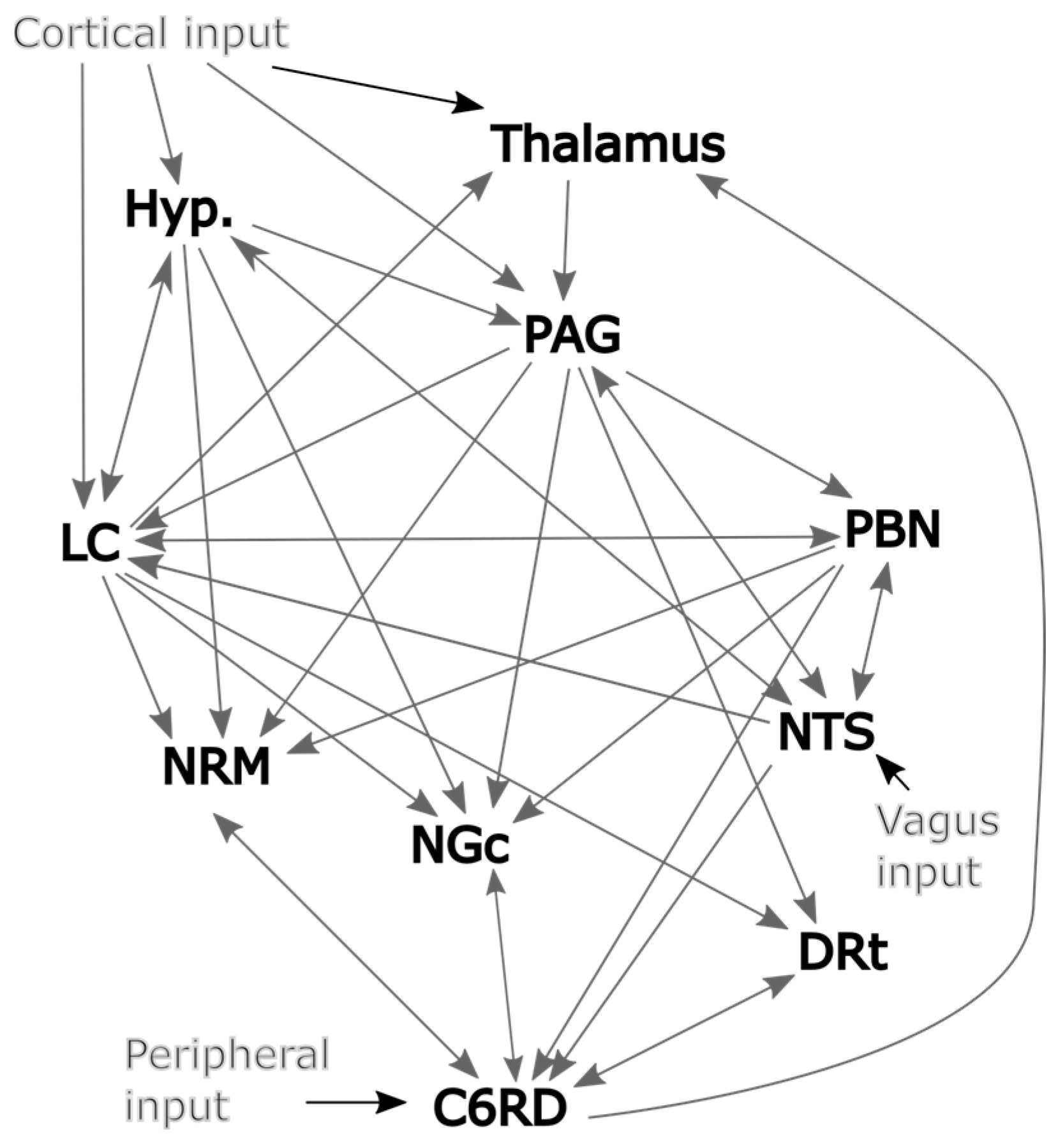
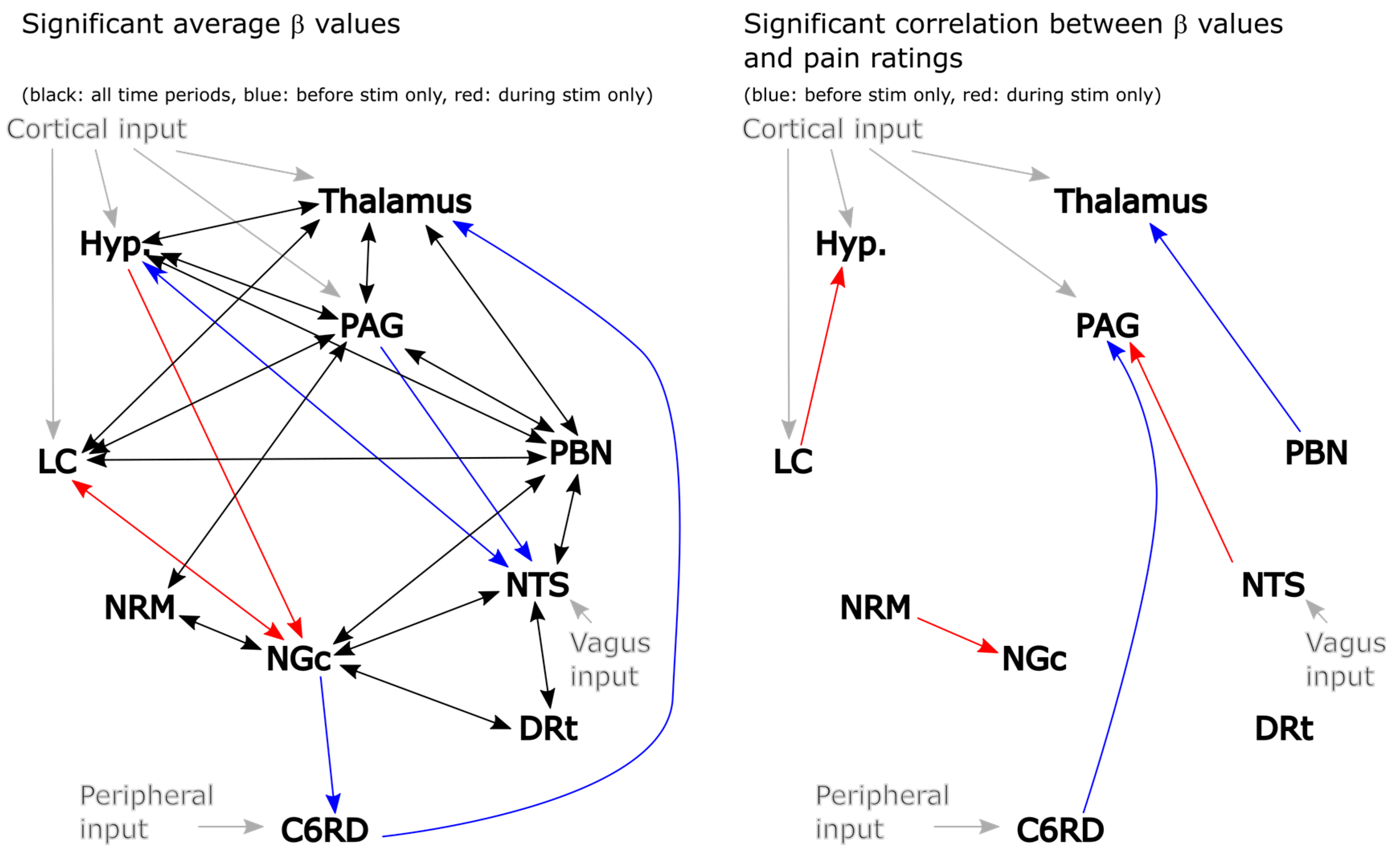
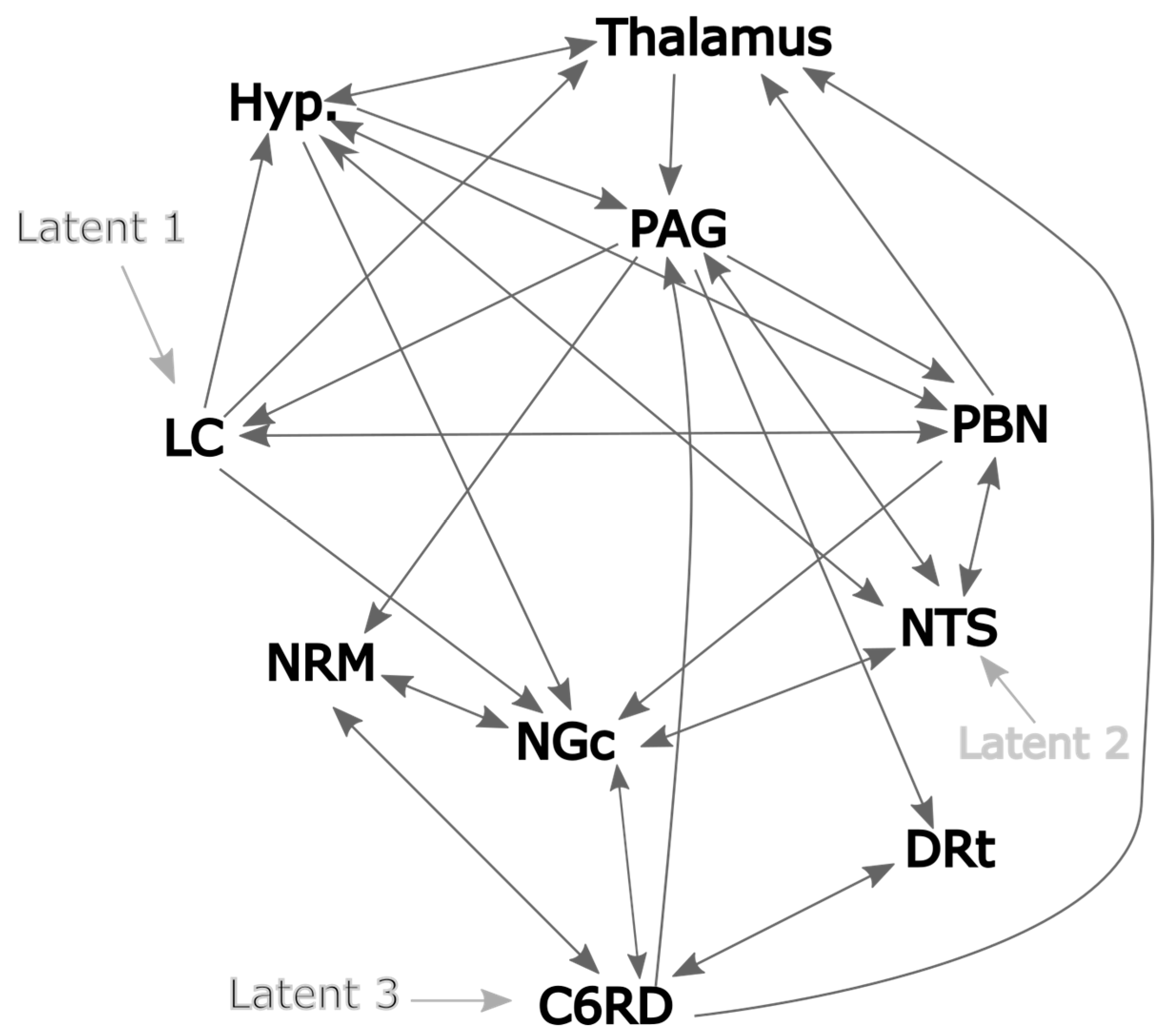
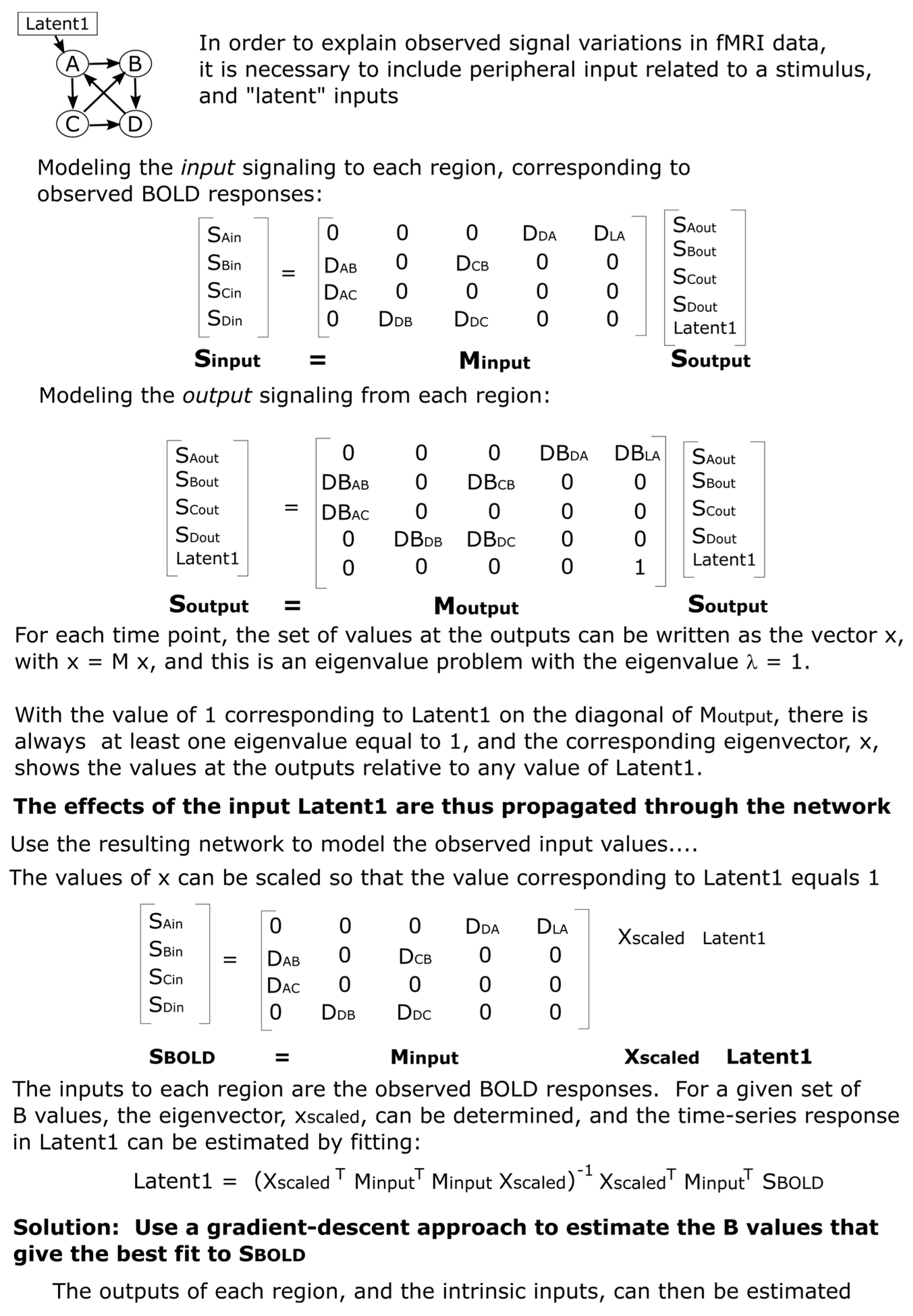
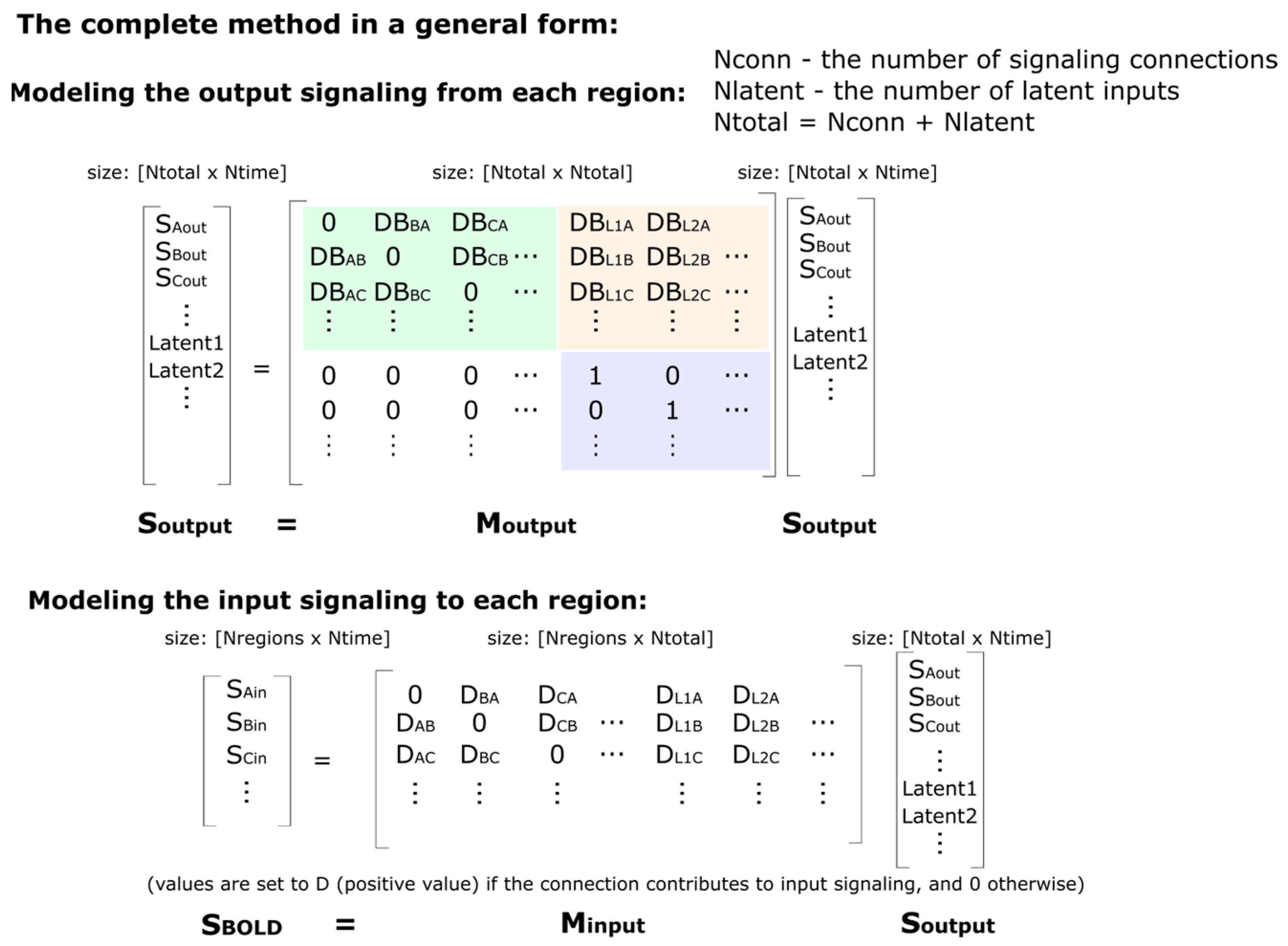

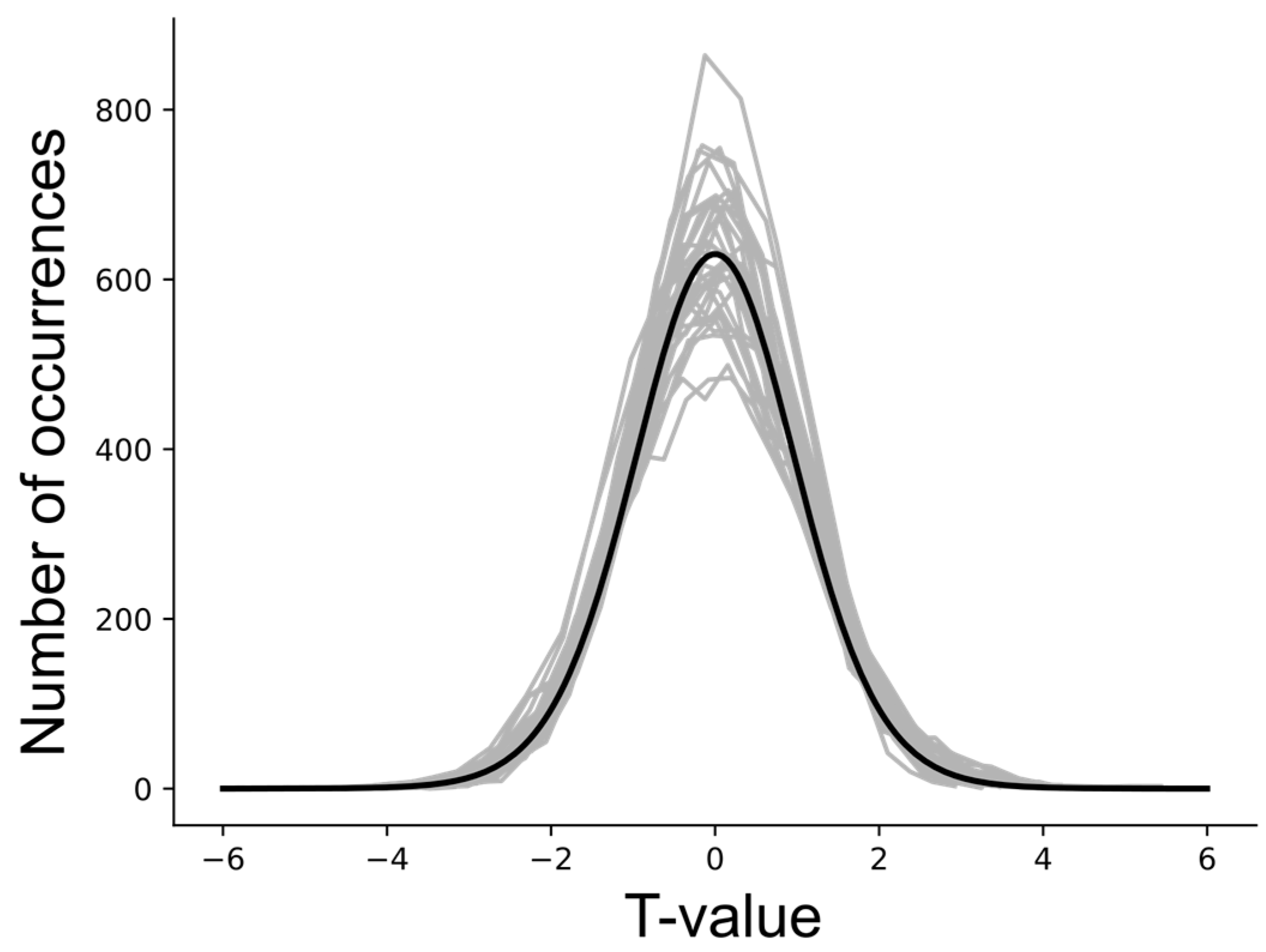


| Study Group | N (F:M) | Average Age | Pain Rating | Temp. (°C) | Stimulus | Paradigm (Pre–Stim–Post) | Conditions |
|---|---|---|---|---|---|---|---|
| Pain Stimulation | 16 (13:3) | 21.3 ± 2.3 | 51.9 ± 8.6 in the “Stim” condition, no ratings for the “No Stim” condition | 48.0 ± 0.8 | 10 heat contacts, every 3 s | 120 s–30 s–120 s | 10 repeated runs; stimulation runs interleaved with runs without stimulation |
| Two Pain | 20 (10:10) | 22.8 ± 3.0 | 48.8 ± 10.1 (High), 42.7 ± 11.5 (Low) | 50.5 ± 0.8 | 10 heat contacts, every 3 s | 120 s–30 s–120 s | 10 repeated runs; runs with a calibrated temperature interleaved with runs that participants believed were at a lower temperature |
| Touch Pain | 19 (9:10) | 24.4 ± 7.0 | 44.7 ± 11.5 (Pain), 9.9 ± 3.8 (Sensation) | 51.1 ± 1.3 (Pain), 40.0 (Sensation) | 10 heat contacts, every 3 s | 120 s–30 s–120 s | 10 repeated runs; noxious stimulation runs interleaved with low temperature (sensation) runs |
| 57 total, 55 in high-pain conditions | 270 s total |
| Connection | All Conditions | Stim | High | Pain | Ref Value | ||||
|---|---|---|---|---|---|---|---|---|---|
| DB | T | DB | T | DB | T | DB | T | ||
| NTS–PBN | 0.273 ± 0.053 | 6.43 | 0.341 ± 0.062 | 6.58 | 0.300 ± 0.095 | 3.91 | 0.162 ± 0.101 | 2.30 | −0.070 |
| PAG–NRM | 0.254 ± 0.049 | 5.92 | 0.230 ± 0.086 | 3.09 | 0.241 ± 0.074 | 3.73 | 0.323 ± 0.093 | 3.85 | −0.036 |
| Thal–PAG | −0.356 ± 0.052 | 5.71 | −0.393 ± 0.079 | −4.23 | −0.259 ± 0.072 | −2.79 | −0.326 ± 0.077 | −3.45 | −0.059 |
| NTS–Hypo | 0.167 ± 0.053 | 5.18 | 0.084 ± 0.105 | 1.82 | 0.263 ± 0.088 | 4.19 | 0.225 ± 0.089 | 3.75 | −0.108 |
| NRM–C6RD | −0.084 ± 0.019 | 3.55 | −0.016 ± 0.025 | 0.02 | −0.114 ± 0.033 | −2.92 | −0.053 ± 0.034 | −1.06 | −0.017 |
| PBN–NTS | 0.112 ± 0.025 | 3.30 | 0.109 ± 0.035 | 2.28 | 0.016 ± 0.043 | −0.30 | 0.118 ± 0.039 | 2.25 | 0.029 |
| NGC–C6RD | 0.018 ± 0.064 | 0.94 | 0.021 ± 0.046 | 1.41 | −0.091 ± 0.135 | −0.36 | 0.151 ± 0.056 | 3.43 | −0.043 |
| Condition | Samples | R2 Average | R2 Total | ||
|---|---|---|---|---|---|
| MEAN ± STD | Range | Mean ± Std | Range | ||
| Null Data | 1000 | 0.255 ± 0.010 | 0.222 to 0.296 | 0.255 ± 0.011 | 0.214 to 0.294 |
| Sub-region set 1 | |||||
| All Pain | 55 | 0.351 ± 0.024 | 0.288 to 0.398 | 0.337 ± 0.077 | 0.207 to 0.600 |
| Stim | 16 | 0.343 ± 0.025 | 0.289 to 0.387 | 0.319 ± 0.069 | 0.212 to 0.480 |
| High | 20 | 0.338 ± 0.020 | 0.305 to 0.382 | 0.316 ± 0.051 | 0.237 to 0.425 |
| Pain | 19 | 0.369 ± 0.020 | 0.332 to 0.400 | 0.383 ± 0.081 | 0.306 to 0.606 |
| Sub-region set 2 | |||||
| All Pain | 55 | 0.342 ± 0.025 | 0.293 to 0.398 | 0.375 ± 0.071 | 0.201 to 0.521 |
| Stim | 16 | 0.339 ± 0.028 | 0.293 to 0.398 | 0.380 ± 0.077 | 0.197 to 0.486 |
| High | 29 | 0.337 ± 0.024 | 0.294 to 0.396 | 0.392 ± 0.062 | 0.278 to 0.519 |
| Pain | 19 | 0.348 ± 0.021 | 0.311 to 0.401 | 0.377 ± 0.089 | 0.196 to 0.496 |
| Sub-region set 3 | |||||
| All Pain | 55 | 0.371 ± 0.032 | 0.312 to 0.522 | 0.290 ± 0.072 | 0.142 to 0.536 |
| Stim | 16 | 0.366 ± 0.024 | 0.316 to 0.406 | 0.265 ± 0.056 | 0.153 to 0.351 |
| High | 29 | 0.382 ± 0.040 | 0.309 to 0.513 | 0.292 ± 0.075 | 0.180 to 0.525 |
| Pain | 19 | 0.363 ± 0.022 | 0.321 to 0.402 | 0.308 ± 0.071 | 0.149 to 0.485 |
Disclaimer/Publisher’s Note: The statements, opinions and data contained in all publications are solely those of the individual author(s) and contributor(s) and not of MDPI and/or the editor(s). MDPI and/or the editor(s) disclaim responsibility for any injury to people or property resulting from any ideas, methods, instructions or products referred to in the content. |
© 2023 by the authors. Licensee MDPI, Basel, Switzerland. This article is an open access article distributed under the terms and conditions of the Creative Commons Attribution (CC BY) license (https://creativecommons.org/licenses/by/4.0/).
Share and Cite
Stroman, P.W.; Umraw, M.; Keast, B.; Algitami, H.; Hassanpour, S.; Merletti, J. Structural and Physiological Modeling (SAPM) for the Analysis of Functional MRI Data Applied to a Study of Human Nociceptive Processing. Brain Sci. 2023, 13, 1568. https://doi.org/10.3390/brainsci13111568
Stroman PW, Umraw M, Keast B, Algitami H, Hassanpour S, Merletti J. Structural and Physiological Modeling (SAPM) for the Analysis of Functional MRI Data Applied to a Study of Human Nociceptive Processing. Brain Sciences. 2023; 13(11):1568. https://doi.org/10.3390/brainsci13111568
Chicago/Turabian StyleStroman, Patrick W., Maya Umraw, Brieana Keast, Hannan Algitami, Shima Hassanpour, and Jessica Merletti. 2023. "Structural and Physiological Modeling (SAPM) for the Analysis of Functional MRI Data Applied to a Study of Human Nociceptive Processing" Brain Sciences 13, no. 11: 1568. https://doi.org/10.3390/brainsci13111568
APA StyleStroman, P. W., Umraw, M., Keast, B., Algitami, H., Hassanpour, S., & Merletti, J. (2023). Structural and Physiological Modeling (SAPM) for the Analysis of Functional MRI Data Applied to a Study of Human Nociceptive Processing. Brain Sciences, 13(11), 1568. https://doi.org/10.3390/brainsci13111568







